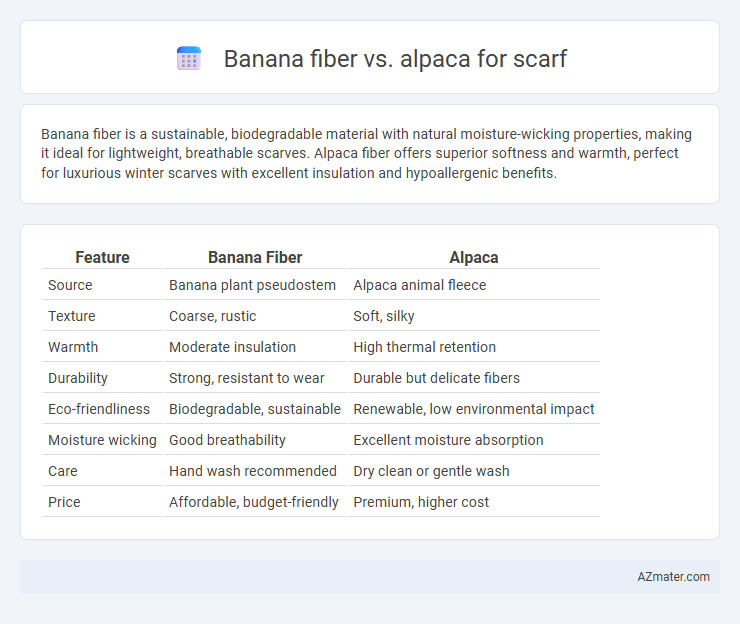Banana fiber is a sustainable, biodegradable material with natural moisture-wicking properties, making it ideal for lightweight, breathable scarves. Alpaca fiber offers superior softness and warmth, perfect for luxurious winter scarves with excellent insulation and hypoallergenic benefits.
Table of Comparison
| Feature | Banana Fiber | Alpaca |
|---|---|---|
| Source | Banana plant pseudostem | Alpaca animal fleece |
| Texture | Coarse, rustic | Soft, silky |
| Warmth | Moderate insulation | High thermal retention |
| Durability | Strong, resistant to wear | Durable but delicate fibers |
| Eco-friendliness | Biodegradable, sustainable | Renewable, low environmental impact |
| Moisture wicking | Good breathability | Excellent moisture absorption |
| Care | Hand wash recommended | Dry clean or gentle wash |
| Price | Affordable, budget-friendly | Premium, higher cost |
Introduction: Comparing Banana Fiber and Alpaca Scarves
Banana fiber scarves are crafted from the sustainable textile derived from banana plant stems, known for their eco-friendly attributes, lightweight texture, and natural sheen. Alpaca scarves, made from the soft undercoat of the South American alpaca, offer exceptional warmth, hypoallergenic properties, and luxurious softness ideal for cold climates. Choosing between banana fiber and alpaca scarves depends on factors like environmental impact, insulation needs, and desired fabric feel.
Sustainability and Environmental Impact
Banana fiber offers exceptional sustainability due to its biodegradable nature and utilization of agricultural waste, minimizing environmental impact by reducing deforestation and chemical use. Alpaca fiber, derived from natural animal hair, supports eco-friendly farming practices with low water and land requirements, promoting biodiversity and carbon sequestration. Both fibers present environmentally responsible choices, with banana fiber excelling in waste valorization and alpaca fiber emphasizing renewable, animal-based resource management.
Origin and Harvesting Process
Banana fiber is derived from the pseudostem of the banana plant, primarily cultivated in tropical regions such as India, the Philippines, and Nepal, where the fiber is extracted through a process of retting and manual stripping after fruit harvest. Alpaca fiber originates from the alpaca, a domesticated South American camelid indigenous to the Andean regions of Peru, Bolivia, and Chile, harvested by shearing the animal annually during the spring. The banana fiber is plant-based and involves agricultural byproduct utilization, while alpaca fiber is animal-derived, emphasizing sustainable animal husbandry practices for fiber collection.
Texture and Softness
Banana fiber scarves offer a crisp, slightly coarse texture with firm durability, making them suitable for structured designs, while alpaca scarves are renowned for their exceptional softness and smooth, silky texture that provides ultimate comfort against the skin. The natural coarseness of banana fiber lends a rustic, organic aesthetic, contrasting with alpaca's fine micron count, which directly correlates to its superior softness and warmth retention. Alpaca fiber scarves are ideal for sensitive skin and colder climates, whereas banana fiber excels in breathability and eco-friendly appeal for lightweight, textured accessories.
Warmth and Insulation Properties
Banana fiber scarves offer moderate warmth with natural breathability, making them suitable for mild to cool climates due to their lightweight insulation and moisture-wicking properties. Alpaca fiber provides superior warmth and insulation, often three times warmer than sheep's wool, due to its hollow core fibers that trap heat effectively while remaining lightweight and soft. For optimal cold-weather protection, alpaca is preferred, whereas banana fiber works well for eco-friendly, breathable scarves in transitional weather.
Durability and Longevity
Banana fiber scarves boast exceptional durability due to their strong cellulose composition, making them resistant to wear and tear over extended periods. Alpaca fibers offer remarkable longevity with natural elasticity and resistance to pilling, ensuring scarves maintain softness and shape through frequent use. Comparing both, banana fiber excels in structural strength, while alpaca provides superior comfort and sustained resilience in cold weather conditions.
Hypoallergenic Qualities
Banana fiber is naturally hypoallergenic, resistant to dust mites and mold, making it an excellent choice for sensitive skin in scarves. Alpaca fiber also offers hypoallergenic properties due to the absence of lanolin, reducing irritation and allergy risks compared to wool. Both fibers provide breathable, soft textures ideal for individuals prone to allergies seeking comfortable scarf options.
Maintenance and Care Requirements
Banana fiber scarves require gentle hand washing with mild detergent and air drying to maintain their natural texture and prevent weakening of the fibers. Alpaca scarves benefit from cool water washing, preferably by hand or using a delicate cycle, and should be dried flat to avoid stretching and pilling. Both materials avoid harsh chemicals, but alpaca fibers typically demand more delicate care to preserve softness and prevent shrinkage.
Cost Comparison and Affordability
Banana fiber scarves typically cost less due to the abundance and lower processing expenses, making them a budget-friendly option for eco-conscious consumers. Alpaca scarves, sourced from South American alpacas and known for their softness and warmth, generally carry higher prices reflecting their luxury status and labor-intensive harvesting. When affordability is the priority, banana fiber offers an economical choice without sacrificing unique texture, while alpaca scarves serve as a premium investment for comfort and durability.
Conclusion: Choosing the Best Fiber for Scarves
Banana fiber offers exceptional durability and eco-friendliness, making it ideal for sustainable scarves with a natural, rustic texture. Alpaca fiber excels in softness, warmth, and lightweight comfort, perfect for luxurious winter scarves. Selecting the best fiber depends on the desired scarf attributes: choose banana fiber for strength and sustainability or alpaca for softness and insulation.

Infographic: Banana fiber vs Alpaca for Scarf
 azmater.com
azmater.com